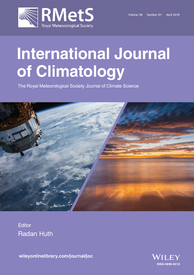
Suman Bhattacharyya
Latest Articles
Article | 03

Characteristics of extreme rainfall in different gridded datasets over India during 1983–2015
S Bhattacharyya, S Sreekesh, A King
DOI: 10.1016/j.atmosres.2021.105930
Abstract
Understanding the spatial and temporal occurrences of extreme rainfall events and their changes is crucial for reducing the risk associated with extreme events, especially under anthropogenic warming. This study presents a comparative analysis of twelve gridded rainfall datasets in representing the spatial and temporal variation of extreme rainfall events and trends in the recent past (1983–2015) in India. The selected datasets fall into four categories: gauge-based (APHRODITE, CPC, GPCC, REGEN), satellite-derived (CHIRPS, PERSIANN-CDR), reanalysis (ERA5, MERRA-2, PGF, and JRA-55), and product merged from these three types (WFDEI and MSWEP). For comparison, a gauge-based, high resolution (0.25° × 0.25°) daily gridded rainfall dataset, prepared by the India Meteorological Department (IMD) is used as a reference dataset. Eleven extreme climate indices, defined by the World Meteorological Organization's Expert Team on Climate Change Detection and Indices (ETCCDI) and the IMD are used to represent the magnitude, frequency, and duration of extreme rainfall events in India. The relative performance of these datasets in capturing extreme rainfall events is evaluated by computing model evaluation matrices i.e. correlation coefficient (CC) and Percentage Bias (PBIAS). Trends in extreme rainfall indices and their magnitudes are calculated using Mann-Kendell and Sen's slope methods respectively, to compare with the IMD dataset. Our study finds large uncertainties in representing extreme rainfall events where in most cases the datasets underestimate higher extreme events compared to the IMD data. GPCC and MSWEP better capture the magnitude, duration, and frequency of extreme rainfall events in India and are comparable to the pattern of the IMD dataset. CHIRPS and ERA5 perform better than other satellite and reanalysis rainfall datasets. All these selected datasets consistently underestimate extreme rainfall events over the northern Himalayan region. The gridded datasets are unable to capture the spatial pattern of observed trends in extreme rainfall indices in India when compared to the IMD dataset.
Article | 02

Assessments of multiple gridded-rainfall datasets for characterizing the precipitation concentration index and its trends in India
S Bhattacharyya, S Sreekesh
DOI: https://doi.org/10.1002/joc.7412
Rainfall is time concentric in nature. The spatial and temporal distribution of rainfall is changing over the Earth with recent anthropogenic warming. The study explores various characteristics of annual and seasonal concentration of rainfall across India using the precipitation concentration index (PCI) and its trends during the period of 1986–2015, based on a high-resolution gauge-based rainfall data (0.25 × 0.25°), obtained from the India Meteorological Department (IMD). An intercomparison is made with 11 other gridded rainfall datasets to infer whether these datasets can reasonably reproduce the spatiotemporal distribution of PCI and its trends in various homogenous rainfall regions of India or not. These datasets are categorized into gauge-based (APHRODITE, GPCC, CPC), satellite-derived (CHIRPS, PERSIANN-CDR), and reanalysis (JRA-55, MERRA-2, NCEP-2, PGF, ERA-Interim, ERA-5). On annual scale, about 8.52, 24.1, and 67.38% of area of India are under moderate, irregular, and strongly irregular rainfall distribution, respectively. Spatial variation of PCI in India is influenced by geographical factors such as latitude, longitude, and elevation. Significant increasing and decreasing trends in annual PCI have been observed in the northeast, eastern, and western coasts of India, respectively. Gridded data intercomparison suggests that the gauge-based APHRODITE, GPCC, and satellite-derived CHIRPS datasets better perform in capturing the temporal and spatial variation of PCI across India when compared to the IMD gridded dataset, whereas the ERA-5 performs better among the reanalysis datasets. However, the rainfall datasets exhibited marked differences with the IMD while estimating the annual and seasonal trend and its magnitude across various regions of India. The JRA-55 overestimated areas of positive trend and its magnitude on annual and seasonal scale. These findings have practical implications for hydroclimatic studies.
Article | 01
